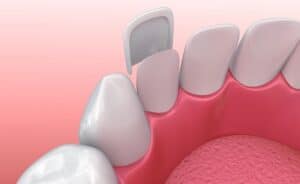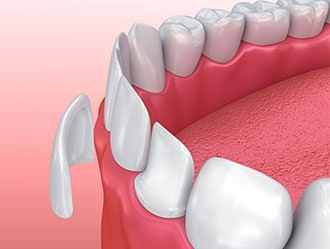Porcelain veneers are thin porcelain facings that are bonded to the front of teeth to change their color, size and/or shape. They can also be used to make mildly crooked teeth appear straight or close a gap between the teeth. If you are dissatisfied with how your smile looks, veneers might be the ideal solution.
Dr. Bhave is a specialist who is highly trained and experienced in aesthetically enhancing smiles using veneers. She works with a local high-tech dental lab that fabricates the veneers according to her exact specifications. She pays attention to detail to give you the look you want, and ensures your veneers look natural in your smile and function comfortably in your mouth.
We offer a complimentary cosmetic consultation with Dr. Bhave so you can find out if veneers are the right procedure to help you achieve your smile goals.
Why Choose Dr. Bhave for Porcelain Veneers
After earning her degree as a general dentist, Dr. Bhave completed three additional years of training and residency to become a prosthodontist – a dental specialist in the aesthetic restoration of teeth and replacement of teeth. A major focus of prosthodontics is cosmetic dentistry, including the placement of veneers. As a specialist, she can create a bright new smile for even the most complex cases.
Dr. Bhave has also taught cosmetic procedures to dental students since becoming a prosthodontist. She currently serves as a clinical assistant professor of prosthodontics at the University of Pacific School of Dentistry in San Francisco.
If you have been looking into porcelain veneers to enhance the look of your smile, or if you just want to learn more about the available options, come see Dr. Bhave for a Complimentary Cosmetic Consultation. Your visit will include:
Conditions Porcelain Veneers Can Fix
Porcelain veneer can correct the following situations:
- Teeth that have rough or pitted surfaces
- Yellowed, stained or discolored teeth
- Broken or chipped teeth
- Mildly crooked teeth
- Misshapen teeth
- Gaps between teeth
Porcelain Veneers Procedure Details
Initial Consultation and Treatment Plan
Dr. Bhave closely consults with you on the look you want. To help her fully understand this, she may have you bring in pictures that show examples of how you would like your teeth to look.
Dr. Bhave obtains enough information from you to completely understand what you are looking for. She then plans the treatment so it meets your desires.
Designing Veneer Dimensions & Color
Dr. Bhave takes an impression of your teeth to be used for planning the exact dimensions of your veneers. She uses a shade guide to determine their exact color and takes pictures of your smile for the lab to use in designing your new smile. She also takes an impression of your upper and lower teeth in biting position to ensure that the veneers will be made to support optimum bite function.
The lab then makes a wax model of how your veneers will look on your teeth. Dr. Bhave presents it to you for approval, making any adjustments necessary on the model until you are happy with the planned end result.
Tooth Preparation and High-Quality Temporary Veneers
Dr. Bhave prepares your teeth for the veneers by gently removing just enough tooth structure to create a strong bonding surface and to make up for the added thickness of the veneer. She takes a full impression of the prepared teeth for use by the lab in creating your final veneers.
She then places temporary veneers onto your teeth that have the exact shape and dimensions worked out on the wax model. She will show you your temporary veneers and get your approval for them as the final design, making any adjustments necessary until you are completely happy with how they look.
If any adjustments were made to the wax model design, Dr. Bhave takes a second impression of your teeth with the temporary veneers. The two impressions, the impression of your bite and your photographs will be used to create your permanent restorations.
Try-In & Final Veneer Placement
Dr. Bhave tests your veneers in your mouth to ensure they look exactly how you want. The cement comes in different shades, so it can be customized to ensure your final teeth are exactly how you want them to look. She uses a “try-in” temporary cement to place the veneers on your teeth so you can look at them as they will appear once bonded permanently.
Dr. Bhave makes any adjustments as needed and obtains your final approval, after which she permanently bonds the veneers to your teeth. Your new veneers will give you a beautiful and bright new smile!
Dental Bonding: Affordable Alternative to Veneers
Cosmetic bonding is a procedure in which a tooth-colored resin is applied to teeth to cover up small cosmetic or structural flaws. In certain circumstances, Dr. Bhave can use bonding material to close small gaps between teeth, repair chips and cover discolored parts of the enamel. She can also use bonding to make teeth longer or change their overall shape.
Cosmetic bonding is a quick and economical solution for minor changes, but is not as strong or as long-lasting as porcelain veneers. Dr. Bhave will let you know what she recommends for your specific situation.
The Benefits of Porcelain Veneers

This cosmetic dentistry option is an excellent way to address your smile issues long term. Veneers may last five to 20 years, depending on how well you adhere to proper oral hygiene and avoid foods and habits such as hard candy and chewing on pens.
These thin shells placed over the front of your teeth are stain-resistant, and their shade is customized to match your natural teeth. Dr. Bhave works with a local high-tech dental lab to create your porcelain veneers and offers a “try-in” to all patients so you can see how your smile will appear once the facings are permanently bonded to the tooth’s surface. She will make necessary adjustments to ensure you are more than happy with your final results.
How to Care for Porcelain Veneers
Caring for your porcelain veneers is crucial for maintaining your new smile. Your dental veneers could last up to 20 years with proper oral hygiene and care. Generally, you should brush, floss and rinse with mouthwash or water after every meal or at least two times a day. To preserve your results, you want to use a soft-bristled toothbrush and non-abrasive toothpaste.
Brush your teeth thoroughly but not aggressively. You could damage the veneers and your natural teeth by causing cracks or chips. Make sure your toothpaste does not contain a whitening agent because your natural teeth may no longer match your porcelain veneers, giving an unnatural appearance.
Avoid chewing on ice, pens and other materials that could damage your porcelain veneers. Your teeth should never be used as tools. You will need to avoid hard, crunchy foods and stop smoking to prevent yellowing of your natural teeth and dental restorations.
Regular dental exams with Dr. Bhave in San Jose can ensure a healthy mouth and help your porcelain veneers last a decade or longer.
Dental Crowns vs. Veneers
Both of these dental restorations can improve the appearance of your smile, but they are fundamentally different in many ways. A porcelain veneer is a thin facing or shell cemented to an existing tooth, while a dental crown is thicker and covers the entire tooth. A crown may be made with porcelain, all-metal alloy or porcelain fused to metal. Both porcelain crowns and veneers match your adjacent teeth and can cover tooth imperfections such as chips and cracks.
A dental crown can be used for cosmetic and restorative purposes, whereas a porcelain veneer is strictly a cosmetic procedure. If you have a root canal, cracked tooth or a large filling, a dental crown is often the best way to restore a healthy mouth and a beautiful smile. A flawed tooth that is otherwise intact can typically be addressed with a porcelain veneer. A dental crown can cause more sensitivity to hot and cold temperatures, and you may experience gum pain. The dental crown process requires removing much more of the natural tooth than dental veneers. Crowns may show a margin of the tooth along the gumline after several years.
Dr. Bhave is a skilled prosthodontist who specializes in cosmetic and restorative dentistry to give you a functional, beautiful smile and will determine the best way to improve your tooth concerns.
What Our Patients Have to Say About Porcelain Veneers

“I came into Dr. Bhave’s office for a veneer consultation. Dr. Bhave is my 3rd consultation. I said yes on our first date! 😀 Her office is brand new, and everyone there was super nice and friendly. I now have a nice set of teeth and not shy about showing them anymore. Thanks, Dr. Bhave!” – Food L.
“I’ve now been here 2x, and they have been so consistent with amazing service. They care about my perspective and really try hard to accommodate my needs. I feel comfortable with them. The entire team is professional and caring/kind. Love them!!!” – Thena D.
Porcelain Veneers FAQs
Why do patients choose porcelain veneers?
Veneers are an easy and quick method for addressing dental issues that might otherwise require more involved procedures. In many cases, veneers are a less expensive and difficult alternative to braces and dental crowns. Patients can choose to get a veneer for a single tooth, or a whole row of them for an attractive, uniform and natural-looking smile.
Veneers act as durable porcelain shields to mask the imperfections on your natural teeth. After they have been cemented into place, they can hide cracks, chips, discoloration or any other imperfection that you may not want on display.
Some patients choose veneers because they are displeased with the length or shape of their existing teeth and want a different style of smile. Others believe the spaces between their teeth are too wide, and a set of veneers can cover up those gaps.
Skilled Bay Area dentist Dr. Ashwini Bhave uses computer modeling to create veneers that match perfectly with either your existing teeth or the kind of teeth you have requested. Most veneers will last at least 10 years, though 20 years is not uncommon for patients who take good care of their teeth.
On top of that, veneers are made out of stain-resistant materials, meaning that people who love to drink coffee and red wine do not need to worry about seeking teeth whitening sessions to keep their teeth sparkling.
When are porcelain veneers not appropriate?
While veneers are a great way to cover up aesthetic flaws, they are not designed to treat legitimate oral health issues. Before you receive veneers, San Jose dentist Dr. Ashwini Bhave will examine your mouth for tooth infection and gum disease, and treat any such issues promptly. For example, veneers will do nothing to stop a decaying tooth, which is why you still need to tend to your natural teeth with fillings.
Dr. Bhave also cautions patients who have a tendency to clench and grind their teeth that their veneers will be at risk for wearing away more quickly than other patients’. Patients who still have their heart set on veneers may opt to wear a mouth guard at night to minimize the amount of chipping and friction that will undermine the veneers.
Patients should be aware that veneers are a permanent decision. Once your teeth have been reshaped to fit veneers, they cannot be reversed in the future, meaning you will have to get veneers again at a later point.
Is the procedure painful?
To put on veneers, Dr. Bhave will have to first remove enamel from the tooth surface. He will provide you with a local anesthetic to keep any discomfort to a minimum. After your veneers are cemented into place, you may experience some swelling of the gums, along with sensitivity to hot and cold foods or drinks, but these minor side effects will be temporary.
Are porcelain veneers the same as dental bonding?
While veneers and dental bonding are similar, there are some critical differences. With a dental bonding procedure, Dr. Bhave will place composite material onto a tooth and then sculpt it to correct misshapen teeth, fill in gaps, add volume to teeth or simply cover up discoloration. The same tooth-colored material can be used to fill cavities. Best of all, bonding does not require the reshaping of your natural tooth, meaning that you can later choose to reverse the procedure. While bonding is less expensive than porcelain veneers, it does not last nearly as long.
What are the different types of veneers?
There are a variety of veneers available today, including composite veneers, which are made out of a tooth-colored resin material, and removable veneers, which act as a temporary solution for concealing dental imperfections. Porcelain veneers are the optimal choice since porcelain, when used in dentistry, is known for its ability to mimic the translucence of teeth. Dr. Bhave exclusively offers porcelain veneers to patients, allowing them to achieve a beautiful, natural-looking smile.
How do I maintain my oral health after getting veneers?
An outstanding benefit associated with veneers is that no special maintenance is required. However, patients should still prioritize their dental health at all times. This means that you should have a solid dental hygiene routine consisting of twice-daily brushing with a quality, soft-bristled toothbrush, as well as thorough flossing to remove all food particles. Routine dental cleanings are also necessary to maintain healthy teeth and gums.
Can I use whitening toothpaste after getting porcelain veneers?
Veneers can last up to two decades with care, meaning you can expect to enjoy a brilliant white smile that enhances your entire appearance for years to come. As such, whitening toothpaste is unnecessary after you have had veneers placed. In fact, it is recommended to avoid whitening toothpastes, as many can be abrasive and even scratch your veneers.
Why do I need temporary veneers?
Temporary veneers are an important step in the process of veneer placement. They are used after your natural teeth have been prepared and impressions have been obtained. Dr. Bhave fits you with your temporary veneers as you wait for your permanent veneers to be created.
Am I a good candidate for dental veneers?
If you are interested in veneers, the best way to find out if this is a suitable treatment for you is to come in for a veneer consultation. During the appointment, Dr. Bhave will conduct a thorough examination of your teeth and gums and discuss your dental cosmetic goals with you. At that time, your candidacy will be determined, but most veneer candidates share the following characteristics:
- Stained teeth
- Minor dental cosmetic issues, such as chips or cracks
- Good oral health
- Realistic expectations
How much should I expect to spend on veneers?
In general, the cost of veneers is based on several factors, including the number of teeth being treated, and the experience level of the professional placing them. Contact our office today to schedule a consultation for veneers, during which an accurate price point can be provided to you.
Will the veneers match my natural tooth color, or can I opt for a brighter shade?
Patients get veneers to improve the overall appearance of their smiles, including the whiteness of their teeth. It is common to get veneers that are whiter than their natural teeth. Dr. Bhave will guide you through the entire process and make recommendations along the way so that you are satisfied with your final result.
How do I get my veneers and teeth to match?
You may need to have your natural teeth professionally whitened to produce a cohesive result. This can occur before or after veneers have been placed, and is a safe, convenient, and effective treatment.






